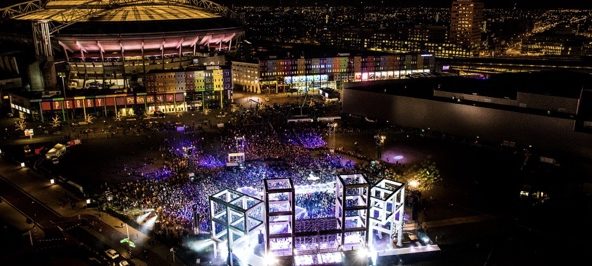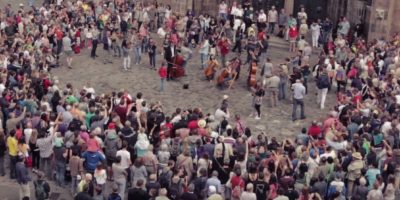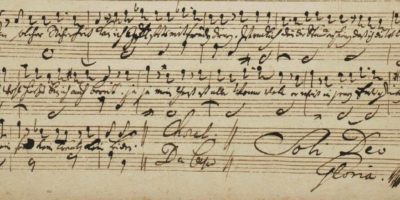A television audience of over three million witnessed a double resurrection miracle via a modern rendition of The Passion story of Jesus played across the city of Amsterdam on the eve of Good Friday last week.
Beginning atop the Amsterdam Tower on the north side of the IJ River, the storyline followed Jesus and his disciples across the water and through the city streets towards his arrest, trial and crucifixion in the south-east district of Bijlmermeer – or ‘Bijlmer’ as it is popularly known.
The spectacle, which for the past seven years has been held in different cities around the Netherlands, is a joint production of the three main Christian broadcasting corporations, Evangelical, Protestant and Catholic. Stage participants are drawn from known artists from all sorts of backgrounds. Contemporary songs are given fresh application in the context of the Biblical story.
A reported crowd of 20,000 gathered around a huge stage and screen near the Amsterdam Arena, home to the Ajax football team, eagerly following the storyline narrated by a former national television news reader, Noraly Beyer. Songs, interviews and drama moved the story towards the arrest and trial of Jesus, dressed in bright orange prison overalls. The climax came when the resurrected Jesus appeared high above the crowd, spotlit on the roof of the Arena.
Beyer, herself a descendent from Surinamese slaves and a Bijlmer resident for 33 years, explained that the actors, soloists and chorus singers had been chosen for their link with the district. ‘Judas’ was well-known singer Jeangu Macrooy, also with a Surinamese background, like many who settled in the Bijlmer after their country’s independence in 1975.
Another ‘disciple’ was Don Seders, a popular young Christian advocate working for the poor in the Bijlmer, recently voted onto the Amsterdam City Council.
Disaster
The ‘Bijlmer’ was thrust into global headlines in 1992 when an El Al cargo jet smashed into two of the 10-storey honeycomb-shaped apartment buildings, demolishing many apartments and killing over 40 people.
From the site of a monument erected in 1996 in memory of the victims, a large neon-lit cross began a ‘Via Dolorosa’ procession carried by locals from the Bijlmer, some of whom had lost family members in the fiery disaster.
The narrator wove the story of the Bijlmer into the backdrop of the evening performance, a story which in itself represented a miracle of resurrection. She explained that this year marked the 50th anniversary of the completion of the first flats in the Bijlmermeer, the reason for the choice of this year’s location.
Now home to some 50,000 people from 150 nationalities, the Bijlmer had been transformed from what the police had called a national disaster area – Holland’s first ghetto synonymous with crime, drugs, unemployment and illegal immigrants – into a vibrant multicultural community.
Missing
The Bijlmer was designed to be a modern ‘radiant city’ for ‘the new man,’ based on the ideas of Swiss architect Le Corbusier. It was a unique experiment of urban planning in the Netherlands, and was the only undertaking of its type in the world. It epitomized the futuristic lifestyle for the Dutch middle-class family, at least in the early 1960s.
Very soon, however, the Dutch began criticising the massive, monotone, endless honeycomb design of the Bijlmer, choosing for smaller-scale housing projects in neighbouring cities. The buildings remained empty on completion until migrants from Suriname began moving in. Half of these were unemployed, living on social benefits.
Until the last decade of last century, the Bijlmer continued to deteriorate as more migrants began settling in the low-cost housing. Many from Africa were practising Christians and immediately noticed a missing element in the community: no churches had been planned for this ‘futuristic, radiant city for the new man’. Secularist thinking had presumed that ‘churches’ would belong to the past.
Believers began gathering in parking garages. Others gathered for prayer and bible study in apartments. Congregations sprang up in offices, spaces under apartments, wherever they could sing, pray and read the Bible together. Some of the victims of the El Al crash had been praying and studying together at the moment of impact.
As part of a renewal programme for the Bijlmer, a large complex was bought eleven years ago, sponsored by the city, for many churches to use for services. Since then, De Kandelaar has been jointly used by fifty churches from fifteen denominations.
Describing these churches as ‘pearls’, former Bijlmer police chief, Danny Williams, said the police had much to thank them for. For the past decade, there has been close cooperation between the churches, the police, politicians and immigration authorities.
Today over 10,000 of those living in the Bijlmer are active church-goers, roughly one in five. Most are youth. As Noraly Beyer told her television audience, they gather in no less than 150 different congregations.
I’d call that a miracle of resurrection. Wouldn’t you?
Till next week,




This is so uplifting Jeff, thanks for sharing this truly inspirational story!
Good to hear wonderful news from a far off,somewhat far-out land,thanks.